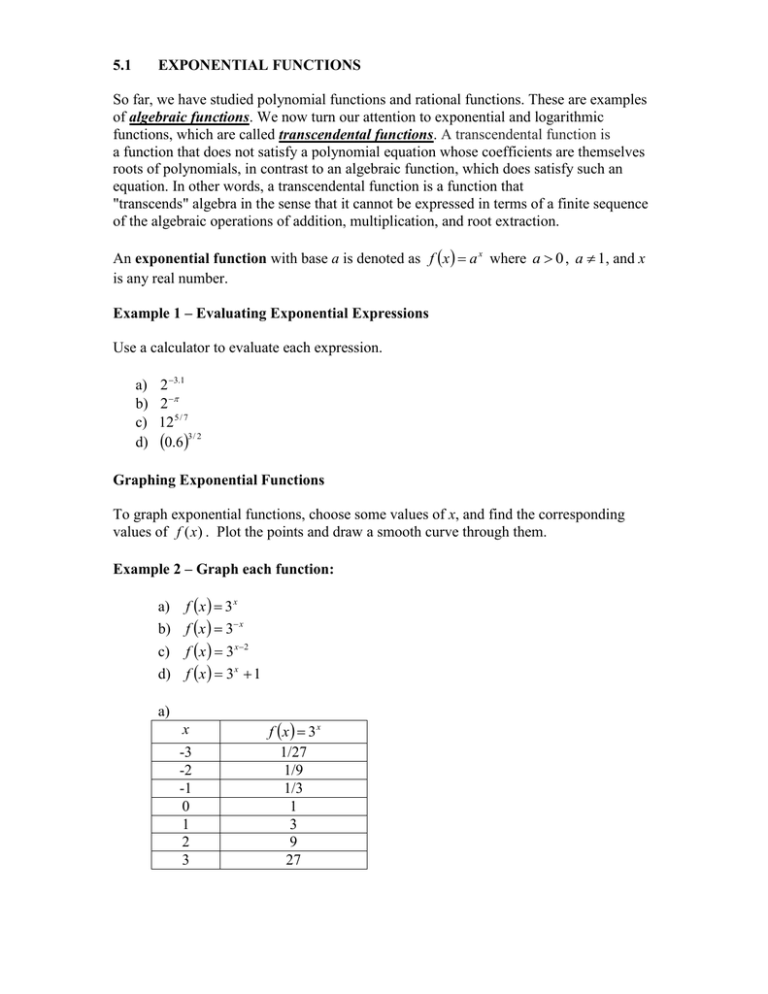MATH 1314 5.1 exponential functions.doc
advertisement

5.1 EXPONENTIAL FUNCTIONS So far, we have studied polynomial functions and rational functions. These are examples of algebraic functions. We now turn our attention to exponential and logarithmic functions, which are called transcendental functions. A transcendental function is a function that does not satisfy a polynomial equation whose coefficients are themselves roots of polynomials, in contrast to an algebraic function, which does satisfy such an equation. In other words, a transcendental function is a function that "transcends" algebra in the sense that it cannot be expressed in terms of a finite sequence of the algebraic operations of addition, multiplication, and root extraction. An exponential function with base a is denoted as f x a x where a 0 , a 1, and x is any real number. Example 1 – Evaluating Exponential Expressions Use a calculator to evaluate each expression. a) 2 3.1 b) 2 c) 125 / 7 3/ 2 d) 0.6 Graphing Exponential Functions To graph exponential functions, choose some values of x, and find the corresponding values of f ( x) . Plot the points and draw a smooth curve through them. Example 2 – Graph each function: a) b) c) d) f x 3 x f x 3 x f x 3 x 2 f x 3 x 1 a) x -3 -2 -1 0 1 2 3 f x 3 x 1/27 1/9 1/3 1 3 9 27 b) x -3 -2 -1 0 1 2 3 c) x 0 1 2 3 4 d) x -2 -1 0 1 2 f x 3 x 27 9 3 1 1/3 1/9 1/27 f x 3 x 2 1/9 1/3 1 3 9 f x 3 x 1 10/9 4/3 2 4 10 Solving Exponential Equations To solve an exponential equation, use the steps below: Step 1 – Each side must have the same base. If the two sides do not have the same base, express each as a power of the same base, if possible. Step 2 – Simplify exponents if necessary, using rules of exponents. Step 3 – Set exponents equal. Step 4 – Solve the equation obtained in Step 3. Example 3 – Solve each equation. x 9 27 x 1 64 4 4 x 2 1 64 3 x 9 27 x The Natural Base e An irrational number, symbolized by the letter e, appears as the base in many applied exponential functions. This irrational number is approximately equal to 2.72. More accurately, e 2.71828 . The number e is called the natural base. The function f x e x is called the natural exponential function. m 1 The number e can be approximated as e 1 for large values of m . m Using a Graphing or Scientific Calculator to Evaluate Powers of e Example 4 – use a calculator to evaluate each: a) b) c) d) e2 e 0.2 e 0.25 e The number e lies between 2 and 3. Therefore, the graph of f x e x lies between the graphs of f x 2x and f x 3x , as seen below. 2.5 2 1.5 1 0.5 -2 -1 1 2



